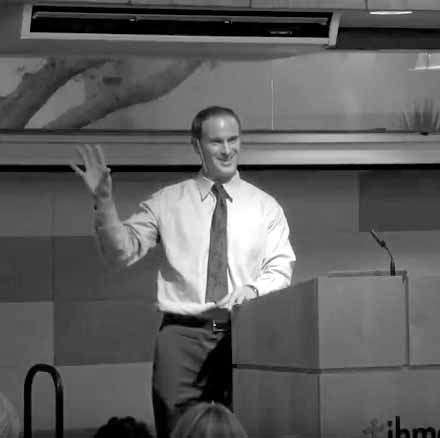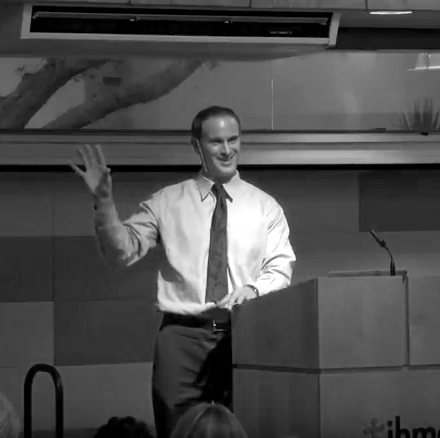Two Keys to Ease Into Intermittent Fasting
Written by Stephen Anton PhD on July 27th, 2020

Unless you have been living under a rock, you have likely heard about the benefits of intermittent fasting.
Benefits attributed to intermittent fasting include fat loss, weight loss, mental clarity, cellular cleansing, improved blood cholesterol profiles, and possible reversal of type 2 diabetes.
While it’s true that there are tremendous benefits to intermittent fasting, there are right and wrong ways to get started with an intermittent fasting lifestyle.
Time-Restricted Feeding
First and foremost, intermittent fasting can mean different things to different people, and there are multiple types of intermittent fasting protocols.
In this article, we’ll focus on an intermittent fasting protocol known as time-restricted feeding (TRF).
TRF is one of the most popular forms of intermittent fasting.
It involves a period where no calories are consumed each day, typically around 16 hours, and a period where you consume all your daily calories, typically around 8 hours.
Let’s learn the two keys to ease into TRF.
Key #1: A Little Bit at a Time
If you’re like most people, running a mile would provide a healthy level of stress, and with a little recovery time, that stress would result in a positive adaptation.
In theory, this means that the next time you ran the same mile, your body would handle it easier.
This is similar to a medical concept called hormesis, which is our first key to ease into the intermittent fasting world.
Hormesis states that a mild dose of a stressor can be helpful, whereas a higher dose of the same stressor can be detrimental.
Imagine this, an untrained person tries to run a full marathon.
This would be a terrible idea because the demands placed on the person’s body would vastly exceed their capacity to adapt during the race.
Essentially, this overwhelms the person’s ability to recover and can lead to a host of unhealthy physiological changes like joint pain, elevated inflammation, and reduced immune function.
Similarly, fasting too long before your body has become fat-adapted can put too much stress on the body.
Key #2: Fat vs. Sugar
“Have you ever built a fire?”
You might start with small twigs and dry leaves, or kindling, which catches fire quickly and burns off just as fast.
This is similar to your body running on sugar for fuel.
Now, when I say sugar, I’m not just talking about candy bars and soda.
Carbohydrates in all forms turn into glucose, sugar, in your body.
Here is a comparison of burning carbs compared to burning fat:
Burning Carbs
If you rely on carbohydrates as your main form of energy, it’s as if you’re trying to keep the fire going with just kindling
Burning Fat
Fat, on the other hand, is more like burning giant logs or even coal in your fire
And, when you become fat-adapted, it means your body can use fat for energy instead of carbohydrates.
The more adapted your body is to using fat for energy, the longer you’ll be able to fast, and the longer you can fast, the more fasting benefits you can receive.
Here’s an important point to think about, our ancestors were likely very fat adapted since the environment was always feast or famine.
The current day problem is that very few people are metabolically flexible, so it is difficult for most of us to tap into our fat stores as a source of energy at first.
What many of us need is a way to help flip, what I call, the metabolic switch.
A Lesson from Corporate Japan
Back in 1986, a Japanese business consultant named Masaaki Imai founded the Kaizen Institute to bring the concepts of Kaizen to western companies.
Kaizen roughly translates to change is good, and the Kaizen principle translates to major change through small, daily improvements over time.
If we apply this concept to fasting, it means we can quickly start to see the benefits of fasting by gradually increasing our fasting time each day.
For example, if you currently eat breakfast at 8 am, you would wait until 8:15 am the next day.
The day after that, you would wait until maybe 8:30, 8:45, or even 9 am, and so on.
As long as you are feeling good and in, what I’ll call, the “healthy fasting zone”, you can continue extending your fasting period.
So, you may be wondering,
“What is a health fasting zone, and how do I know if I’m experiencing it?”
Indicators of Successful Fasting
Below are a few key indicators of a healthy fasting zone:
You are very comfortable going at least 8-12 hours between meals
Absence of headache, dizziness, and light-headed feelings
Happy and enthusiastic feelings about life
None or only minor feelings of hunger
Capable of working at a high-level
Great focus and mental clarity
Energized yet calm feeling
Relaxed muscles
This is not an exhaustive list, but it’s enough to get you started.
If, during, your fasting time you have the above feelings you’re most likely fine and you can even go further.
Dealing with Fasting Criticism
An obstacle you might face in your fasting journey is the criticism of armchair “experts” who think you’re crazy for not eating 3, 5, 7, or more meals a day.
It’s not uncommon for people to feel great going 24, 36, 48 hours or more in between meals once they’ve become sufficiently adapted to using both dietary and stored body fat as their primary fuel source.
Main Takeaways
Anyone can experience the benefits of intermittent fasting.
The pivotal part is getting started in the right way.
Remember to take it a step at a time, and you will be able to shift your source of fuel from sugar to fat.
More on intermittent fasting:
Intermittent Fasting Immune System: The Boosting Effects of Fasting
Two Keys to Ease Into Intermittent Fasting
Written by Stephen Anton PhD on July 27th, 2020

Unless you have been living under a rock, you have likely heard about the benefits of intermittent fasting.
Benefits attributed to intermittent fasting include fat loss, weight loss, mental clarity, cellular cleansing, improved blood cholesterol profiles, and possible reversal of type 2 diabetes.
While it’s true that there are tremendous benefits to intermittent fasting, there are right and wrong ways to get started with an intermittent fasting lifestyle.
Time-Restricted Feeding
First and foremost, intermittent fasting can mean different things to different people, and there are multiple types of intermittent fasting protocols.
In this article, we’ll focus on an intermittent fasting protocol known as time-restricted feeding (TRF).
TRF is one of the most popular forms of intermittent fasting.
It involves a period where no calories are consumed each day, typically around 16 hours, and a period where you consume all your daily calories, typically around 8 hours.
Let’s learn the two keys to ease into TRF.
Key #1: A Little Bit at a Time
If you’re like most people, running a mile would provide a healthy level of stress, and with a little recovery time, that stress would result in a positive adaptation.
In theory, this means that the next time you ran the same mile, your body would handle it easier.
This is similar to a medical concept called hormesis, which is our first key to ease into the intermittent fasting world.
Hormesis states that a mild dose of a stressor can be helpful, whereas a higher dose of the same stressor can be detrimental.
Imagine this, an untrained person tries to run a full marathon.
This would be a terrible idea because the demands placed on the person’s body would vastly exceed their capacity to adapt during the race.
Essentially, this overwhelms the person’s ability to recover and can lead to a host of unhealthy physiological changes like joint pain, elevated inflammation, and reduced immune function.
Similarly, fasting too long before your body has become fat-adapted can put too much stress on the body.
Key #2: Fat vs. Sugar
“Have you ever built a fire?”
You might start with small twigs and dry leaves, or kindling, which catches fire quickly and burns off just as fast.
This is similar to your body running on sugar for fuel.
Now, when I say sugar, I’m not just talking about candy bars and soda.
Carbohydrates in all forms turn into glucose, sugar, in your body.
Here is a comparison of burning carbs compared to burning fat:
Burning Carbs
If you rely on carbohydrates as your main form of energy, it’s as if you’re trying to keep the fire going with just kindling
Burning Fat
Fat, on the other hand, is more like burning giant logs or even coal in your fire
And, when you become fat-adapted, it means your body can use fat for energy instead of carbohydrates.
The more adapted your body is to using fat for energy, the longer you’ll be able to fast, and the longer you can fast, the more fasting benefits you can receive.
Here’s an important point to think about, our ancestors were likely very fat adapted since the environment was always feast or famine.
The current day problem is that very few people are metabolically flexible, so it is difficult for most of us to tap into our fat stores as a source of energy at first.
What many of us need is a way to help flip, what I call, the metabolic switch.
A Lesson from Corporate Japan
Back in 1986, a Japanese business consultant named Masaaki Imai founded the Kaizen Institute to bring the concepts of Kaizen to western companies.
Kaizen roughly translates to change is good, and the Kaizen principle translates to major change through small, daily improvements over time.
If we apply this concept to fasting, it means we can quickly start to see the benefits of fasting by gradually increasing our fasting time each day.
For example, if you currently eat breakfast at 8 am, you would wait until 8:15 am the next day.
The day after that, you would wait until maybe 8:30, 8:45, or even 9 am, and so on.
As long as you are feeling good and in, what I’ll call, the “healthy fasting zone”, you can continue extending your fasting period.
So, you may be wondering,
“What is a health fasting zone, and how do I know if I’m experiencing it?”
Indicators of Successful Fasting
Below are a few key indicators of a healthy fasting zone:
You are very comfortable going at least 8-12 hours between meals
Absence of headache, dizziness, and light-headed feelings
Happy and enthusiastic feelings about life
None or only minor feelings of hunger
Capable of working at a high-level
Great focus and mental clarity
Energized yet calm feeling
Relaxed muscles
This is not an exhaustive list, but it’s enough to get you started.
If, during, your fasting time you have the above feelings you’re most likely fine and you can even go further.
Dealing with Fasting Criticism
An obstacle you might face in your fasting journey is the criticism of armchair “experts” who think you’re crazy for not eating 3, 5, 7, or more meals a day.
It’s not uncommon for people to feel great going 24, 36, 48 hours or more in between meals once they’ve become sufficiently adapted to using both dietary and stored body fat as their primary fuel source.
Main Takeaways
Anyone can experience the benefits of intermittent fasting.
The pivotal part is getting started in the right way.
Remember to take it a step at a time, and you will be able to shift your source of fuel from sugar to fat.
More on intermittent fasting:
Intermittent Fasting Immune System: The Boosting Effects of Fasting

Get the Beginner’s Guide to Intermittent Fasting
Take advantage of this FREE PDF and learn the basics of intermittent fasting.

Get the Beginner’s Guide to Intermittent Fasting
Take advantage of this 100% free PDF and learn the basics of intermittent fasting.

Get the Beginner’s Guide to Intermittent Fasting
Take advantage of this FREE PDF and learn the basics of intermittent fasting.









